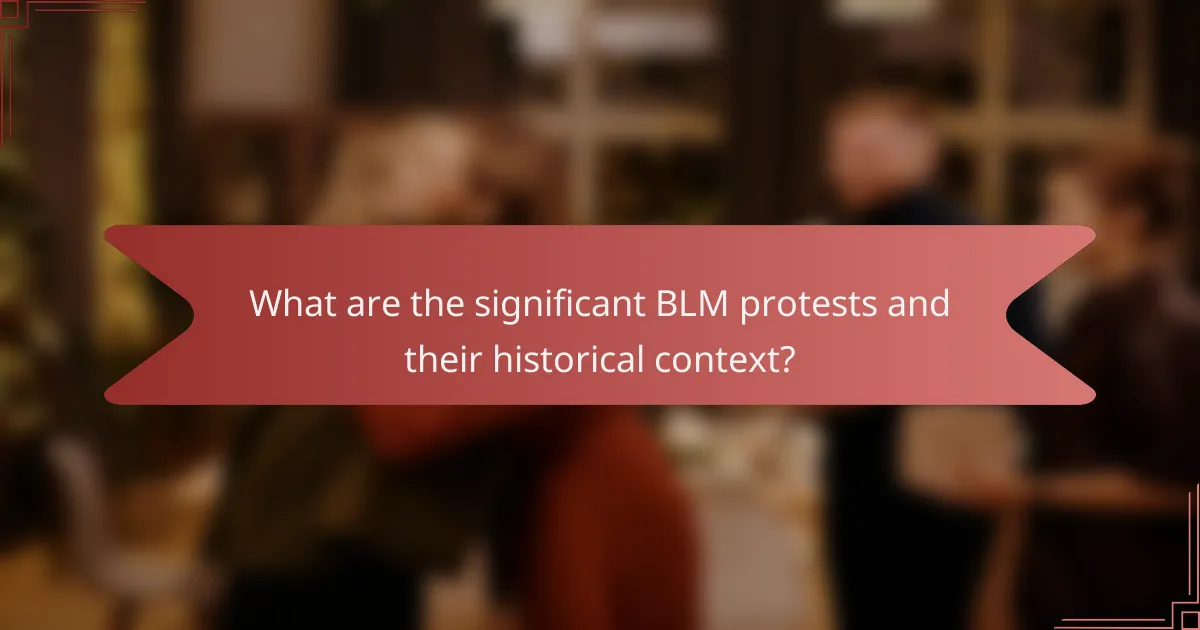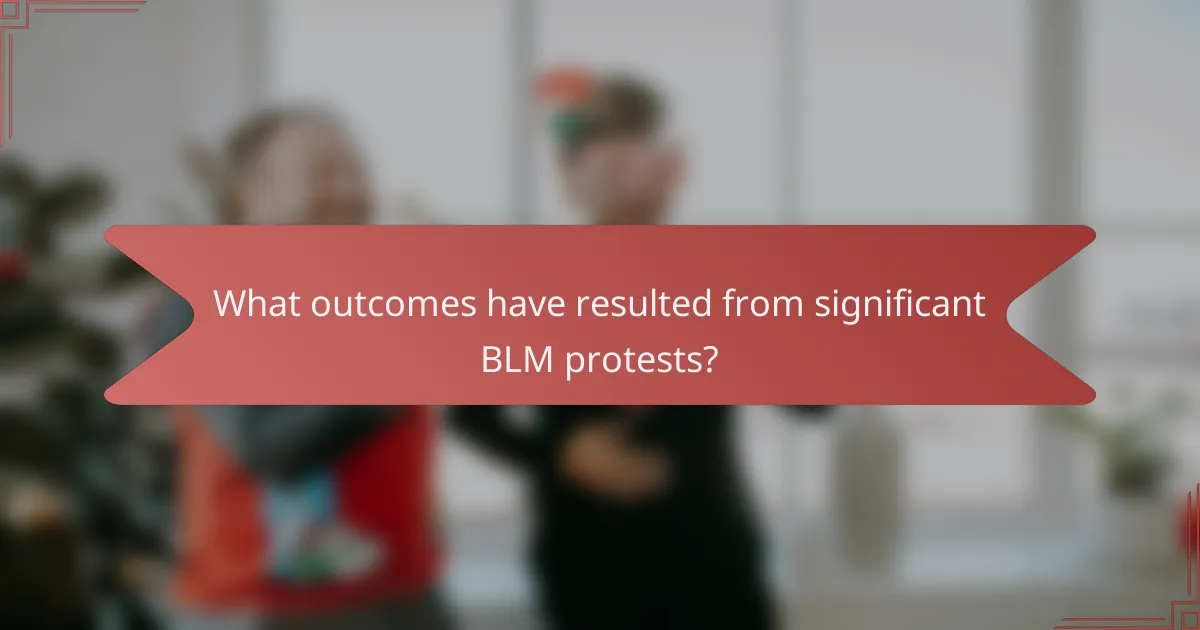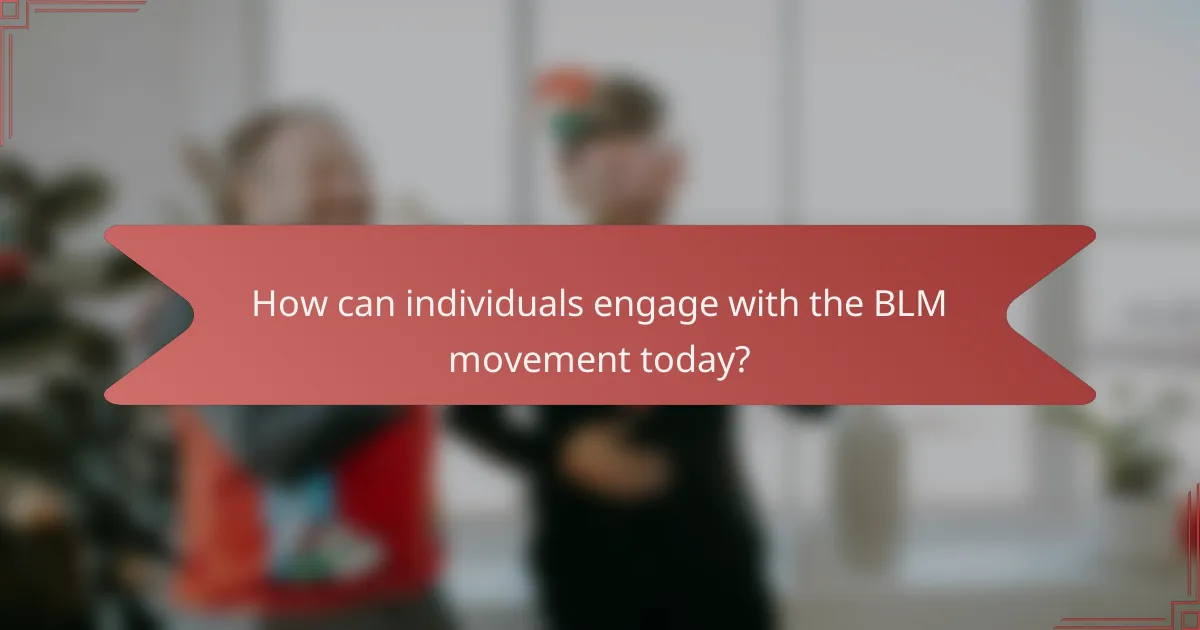
What are the significant BLM protests and their historical context?
The significant BLM protests include the 2014 Ferguson protests, the 2015 Baltimore protests, and the 2020 George Floyd protests. The Ferguson protests erupted after the police shooting of Michael Brown, highlighting systemic racism. The Baltimore protests followed the death of Freddie Gray in police custody, sparking national outrage. The George Floyd protests began after the murder of George Floyd by a police officer in Minneapolis. These protests drew millions globally and demanded racial justice and police reform. Historical context includes the long-standing issues of racial inequality in the U.S. The Black Lives Matter movement started in 2013, focusing on systemic racism and police violence. Each protest served to amplify calls for justice and accountability in law enforcement.
How did the Black Lives Matter movement begin?
The Black Lives Matter movement began in 2013. It was initiated by activists Alicia Garza, Patrisse Cullors, and Opal Tometi. They created the hashtag #BlackLivesMatter on social media. This was in response to the acquittal of George Zimmerman. Zimmerman was charged in the shooting death of Trayvon Martin. The movement gained momentum through online platforms. It highlighted systemic racism and police violence against Black individuals. Protests erupted across the United States following high-profile incidents of racial injustice. These events solidified Black Lives Matter as a significant social movement.
What events triggered the formation of the BLM movement?
The Black Lives Matter (BLM) movement was triggered by the acquittal of George Zimmerman in the shooting death of Trayvon Martin in 2013. This event sparked outrage and mobilization among activists advocating for racial justice. The hashtag #BlackLivesMatter emerged on social media, highlighting systemic racism and police violence against Black individuals. The movement gained further momentum following the deaths of Michael Brown in Ferguson, Missouri, and Eric Garner in New York City in 2014. These incidents led to widespread protests and calls for police reform. The BLM movement has since become a global phenomenon, addressing issues of racial inequality and injustice.
How has the BLM movement evolved over time?
The Black Lives Matter (BLM) movement has evolved significantly since its inception in 2013. Initially sparked by the acquittal of George Zimmerman in the Trayvon Martin case, the movement focused on addressing systemic racism and police violence against Black individuals. Over time, BLM expanded its scope to include broader social justice issues, such as economic inequality and voting rights.
The movement gained international attention following the murder of George Floyd in May 2020. This event catalyzed widespread protests across the United States and globally. The protests highlighted the urgency of addressing police brutality and systemic racism. In response, many cities and states implemented policy changes, such as police reforms and funding reallocations.
BLM has also utilized social media to mobilize support and raise awareness. The hashtag #BlackLivesMatter became a rallying cry, uniting activists worldwide. Additionally, the movement has fostered a diverse coalition, including various organizations and individuals advocating for racial justice.
The BLM movement continues to adapt to current events and societal needs, maintaining its focus on advocating for Black lives and challenging systemic inequalities.
What are the key locations of significant BLM protests?
Key locations of significant BLM protests include cities like Minneapolis, New York City, and Los Angeles. Minneapolis is notable for the protests following George Floyd’s death in May 2020. New York City saw large gatherings in response to police violence and systemic racism. Los Angeles hosted significant protests, emphasizing the movement’s national reach. Other important locations include Seattle, Washington, D.C., and Atlanta. Seattle’s protests highlighted issues of police reform. Washington, D.C. served as a focal point for national demonstrations. Atlanta’s protests were significant for their local context and engagement. Each location represents a critical moment in the BLM movement’s history.
Which cities have been the focal points for BLM protests?
The cities that have been focal points for BLM protests include Minneapolis, New York City, Los Angeles, and Seattle. Minneapolis gained attention after the death of George Floyd in May 2020. New York City saw large gatherings in response to various incidents of police violence. Los Angeles hosted numerous protests, especially during the summer of 2020. Seattle became notable for its protests and the establishment of the Capitol Hill Autonomous Zone. Other cities like Atlanta, Chicago, and Washington D.C. also experienced significant protests. These cities collectively represented a broader movement advocating for racial justice and police reform.
What factors contribute to the selection of protest locations?
Protest locations are selected based on strategic visibility, accessibility, and symbolic significance. High-traffic areas ensure maximum exposure to media and public. Accessibility allows more participants to join the protest easily. Locations with historical or political significance amplify the message. Proximity to government buildings can increase pressure on decision-makers. Safety considerations also influence location choice, aiming to minimize conflict with law enforcement. Community support and local sentiment are critical in determining the appropriateness of a site. These factors collectively enhance the effectiveness of the protest.
What dates mark significant BLM protests?
Significant dates marking BLM protests include May 25, 2020, the date George Floyd was murdered. This event sparked widespread protests across the U.S. and worldwide. Another key date is June 6, 2020, when one of the largest protests took place, with over 1 million participants in various cities. Additionally, July 2020 saw protests in response to the shooting of Jacob Blake on August 23, 2020. These dates represent pivotal moments in the BLM movement, highlighting public response to racial injustice and police violence.
What were the major protest dates and their significance?
The major protest dates for the Black Lives Matter (BLM) movement include May 25, 2020, and June 6, 2020. May 25, 2020, marks the day George Floyd was murdered by a police officer in Minneapolis. This event sparked nationwide protests against police brutality and systemic racism. June 6, 2020, saw one of the largest protests in U.S. history, with over 2 million participants across various cities. This date highlighted the widespread support for the movement and the demand for justice and reform.
How do these dates correlate with key events in the movement?
The dates of significant BLM protests correlate directly with pivotal events in the movement. For instance, the protests following George Floyd’s death on May 25, 2020, marked a global outcry against police brutality. This event catalyzed protests in over 2,000 cities worldwide, highlighting systemic racism. Another key date is August 9, 2014, when Michael Brown was fatally shot in Ferguson, Missouri. This incident sparked the Ferguson protests, which were crucial in shaping the BLM narrative. Each date represents a turning point that mobilized communities and influenced public policy discussions. The correlation between these dates and events demonstrates the movement’s responsiveness to incidents of racial injustice.

What outcomes have resulted from significant BLM protests?
Significant BLM protests have led to increased awareness of racial injustice and police brutality. These protests have prompted discussions on systemic racism across various platforms. Legislative changes have occurred in some regions, including police reform measures. Public support for the Black Lives Matter movement has surged, influencing political agendas. Corporate commitments to diversity and inclusion have increased in response to protest pressures. The protests have also inspired global movements advocating for racial equality. Increased voter registration and participation among marginalized communities have been observed. Overall, these outcomes reflect a shift in societal attitudes towards race and justice.
How have protests influenced public policy and legislation?
Protests have significantly influenced public policy and legislation by raising awareness and prompting governmental action. The Black Lives Matter (BLM) protests, particularly in 2020, led to a surge in discussions about police reform. Numerous cities implemented changes to policing policies, such as banning chokeholds and increasing accountability measures. For instance, the city of Minneapolis, where George Floyd was killed, moved to dismantle its police department.
Additionally, several states passed new laws aimed at addressing racial injustice and police practices. In California, the state legislature enacted Assembly Bill 392, which restricts the use of deadly force by police. Nationally, the George Floyd Justice in Policing Act was introduced to address systemic racism in law enforcement.
These changes demonstrate that protests can mobilize public opinion and lead to tangible legislative outcomes. The influence of protests on policy is evident in the rapid response from lawmakers and the shift in public discourse surrounding racial equality and justice.
What specific laws or reforms have been enacted as a result?
The specific laws and reforms enacted as a result of the Black Lives Matter protests include the George Floyd Justice in Policing Act. This act aims to address police misconduct and increase accountability. It proposes measures such as banning chokeholds and no-knock warrants at the federal level. Additionally, it requires data collection on police encounters. Another significant reform is the establishment of various state-level police reform laws. These laws focus on use-of-force standards, body camera requirements, and community oversight boards. Many cities have also implemented changes in their police department budgets, reallocating funds towards community services. These legislative actions reflect the ongoing impact of the protests on policy and reform efforts.
How do these outcomes reflect societal changes?
The outcomes of the significant BLM protests reflect profound societal changes regarding racial justice and equality. Increased public awareness of systemic racism has emerged from these protests. The protests have mobilized diverse groups across various demographics. This indicates a shift towards a more inclusive dialogue about race. Legislative changes, such as police reform initiatives, have been proposed in response to the protests. Public opinion polls show growing support for racial equity measures. Additionally, corporate commitments to diversity have surged, reflecting changing societal expectations. Overall, these outcomes signify a collective demand for accountability and transformation in societal structures.
What impact have protests had on community awareness and engagement?
Protests have significantly increased community awareness and engagement. They have highlighted social injustices and mobilized individuals to take action. For example, the Black Lives Matter protests in 2020 led to widespread discussions about systemic racism. Many communities organized forums and events to address these issues. Research shows that participation in protests correlates with higher civic engagement levels. A study from the Pew Research Center indicated that 51% of participants felt more informed about racial issues after attending protests. This increased awareness often leads to community initiatives aimed at social change.
How have protests changed public perception of racial issues?
Protests have significantly shifted public perception of racial issues. The Black Lives Matter movement, particularly after George Floyd’s death in 2020, brought widespread attention to systemic racism. Surveys indicate that support for racial justice initiatives increased dramatically during this period. For example, a Gallup poll showed that 67% of Americans supported the movement in June 2020, up from 37% in 2016. Additionally, protests have led to discussions about police reform and social justice in mainstream media. Many companies have publicly committed to diversity and inclusion initiatives as a direct response to the protests. This change in perception has fostered a broader dialogue about race in America, influencing both policy and societal attitudes.
What role do community organizations play in sustaining awareness?
Community organizations play a crucial role in sustaining awareness of social issues. They mobilize local populations through education and outreach initiatives. These organizations often host events, workshops, and discussions to engage the community. They provide platforms for marginalized voices, amplifying their concerns and experiences. Research indicates that sustained community engagement leads to increased awareness and advocacy. For instance, organizations involved in the Black Lives Matter movement have successfully raised awareness through coordinated protests and campaigns. This grassroots approach fosters a sense of collective responsibility and action.

How can individuals engage with the BLM movement today?
Individuals can engage with the BLM movement today by participating in local protests and events. Attending these gatherings raises awareness about racial injustice. Volunteering with local organizations supports community initiatives. Donating to BLM-affiliated charities helps fund their efforts. Educating oneself and others about systemic racism fosters informed discussions. Sharing information on social media amplifies the movement’s message. Advocating for policy changes influences local and national legislation. Supporting Black-owned businesses contributes to economic empowerment.
What actions can individuals take to support BLM initiatives?
Individuals can support BLM initiatives by educating themselves about systemic racism and social justice issues. They can read books and articles from Black authors and activists to gain deeper insights. Attending local BLM events and protests demonstrates solidarity and raises awareness. Donating to organizations that support racial justice, such as the NAACP or Black Lives Matter, provides financial resources for their efforts. Volunteering time and skills to these organizations can also make a significant impact. Additionally, individuals can use their social media platforms to amplify Black voices and share educational resources. Engaging in conversations about racism with friends and family helps spread awareness and encourages others to take action. Supporting Black-owned businesses contributes to economic empowerment within the community.
How can people participate in local protests or events?
People can participate in local protests or events by attending organized gatherings. They can find information about these events through social media, community boards, or local activist groups. Participation often includes marching, holding signs, or expressing solidarity with speakers. Individuals can also volunteer to help with logistics, such as setting up or distributing materials. Engaging in discussions about the cause can further amplify their impact. Many protests encourage participants to share their experiences online to raise awareness. Local governments often provide permits for public gatherings, ensuring that events are lawful. Historical examples show that community involvement can lead to significant social change.
What resources are available for education on racial justice?
Educational resources on racial justice include books, online courses, and documentaries. Notable books include “How to Be an Antiracist” by Ibram X. Kendi and “The New Jim Crow” by Michelle Alexander. Online platforms such as Coursera and edX offer courses on racial equity and justice. Documentaries like “13th” and “I Am Not Your Negro” provide visual insights into racial issues. Organizations like the NAACP and Race Forward offer educational materials and training. These resources facilitate a deeper understanding of systemic racism and social justice movements.
What best practices should individuals follow when participating in protests?
Individuals should follow several best practices when participating in protests. First, they should stay informed about the protest’s purpose and goals. Understanding the context helps participants engage meaningfully. Second, individuals should plan their route and transportation ahead of time. This ensures timely arrival and a safe exit strategy. Third, wearing comfortable clothing and sturdy shoes is essential for mobility. Participants should also bring necessary supplies, such as water and snacks. Fourth, it is important to respect the rules and guidelines set by organizers. Following these helps maintain order and safety. Fifth, individuals should remain peaceful and avoid confrontations. Nonviolent participation is crucial for positive outcomes. Lastly, being aware of local laws can prevent legal issues. Knowing one’s rights enhances personal safety during protests.
How can participants ensure their safety during protests?
Participants can ensure their safety during protests by following specific guidelines. They should stay aware of their surroundings at all times. Keeping a safe distance from potential confrontations is crucial. Wearing comfortable clothing and sturdy shoes helps in mobility. Participants should carry identification and emergency contact information. Staying hydrated and having a first aid kit can be beneficial. It is also important to have a communication plan with fellow participants. Following the instructions of organizers and law enforcement can enhance safety. Finally, understanding local laws regarding protests can prevent legal issues.
What etiquette should be observed in protest settings?
In protest settings, participants should observe respectful communication and non-violence. Respectful communication includes listening to others and avoiding aggressive language. Non-violence is essential to maintain safety and promote a positive message. Participants should also respect the space and property of others. This includes not vandalizing or damaging property during protests. Additionally, following local laws and guidelines is crucial to ensure the protest remains lawful. Being aware of the surroundings and the feelings of others fosters a more inclusive environment. These etiquette practices help create a constructive atmosphere for dialogue and change.
The main entity of this article is the significant protests associated with the Black Lives Matter (BLM) movement, focusing on key locations, dates, and outcomes. The article outlines notable protests, including those in Ferguson, Baltimore, and Minneapolis, and their historical context related to systemic racism and police violence. It discusses the evolution of the BLM movement since its inception in 2013, the factors influencing protest locations, and the legislative changes prompted by these demonstrations. Additionally, the article highlights the impact of protests on community awareness, public perception of racial issues, and individual engagement with the movement today.